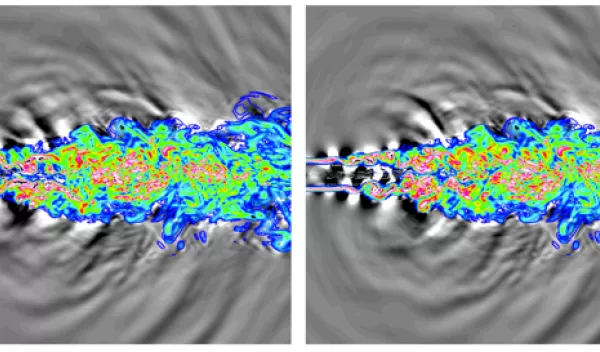
Reducing Jet Noise by Controlling Turbulence
Airlines and aircraft manufacturers are under increasing pressure to keep noise levels low for airport personnel and for people in surrounding neighborhoods.
In fact, about every 10 years, the International Civil Aviation Organization, whose recommendations influence policies in the United States and abroad, reduces the maximum noise an airplane can produce before it can be certified and sold to commercial airlines.
Aircraft are barely able to meet the current levels now. When the noise levels drop again in a few years, no one has a ready-made solution, according to industry observers.
Airplane waves
On the surface, sound is a relatively simple phenomenon. A mechanical wave travels through a compressible medium, such as air, and reaches our eardrums where it is converted into an electric signal and interpreted by the brain. When the sound is generated by an airplane's jet engines, how can it be controlled without impacting the performance of the aircraft?
Daniel Bodony, along with Jon Freund, and Jeonglae Kim, all of the University of Illinois at Urbana-Champaign (UIUC), is working on this very issue. Bodony is part of a NASA-funded effort to lessen jet engine noise by controlling the unsteady movement of air, also known as turbulence.
Instead of working in a wind tunnel or laboratory, the team uses the Ranger supercomputer at the Texas Advanced Computing Center (TACC) to simulate the evolution of turbulence-generated sound waves from jet engine exhaust. The simulations help explain how sound is generated on the most basic level, and also how it can be controlled using a new device.
"We're studying the controlled jet and the uncontrolled jet to understand what changes between them," Bodony said. "That's what experiments can't currently do and what is missing from our understanding of the science."
Simulating flight
Bodony, Freund and Kim use a numerical technique called "large eddy simulation" to simulate the motion of the air around the jet. The simulations show the amount of turbulence flowing in the jet and, importantly, the amount of sound this turbulence creates.
"Unfortunately, the noise is not generated where you can control it directly, so you have to add a control someplace else, like on the nozzle, and tickle the flow in such a way that the sound is reduced at a later spot in the jet," Bodony explained.
After conducting four years of research, Bodony and his collaborators have developed a novel technique to determine the optimal controller required to reduce jet noise. The controller is a plasma actuator based on those developed by colleagues at Ohio State--something like a giant spark plug--that alters the sound field by injecting heat.
Reducing sound
"We can't squash the turbulence," Bodony said. "Our controllers aren't that strong and it may not even be possible or desirable. As a result, we add additional perturbations to reorganize the pre-existing disturbances, so that the unsteady forces and stresses within the fluid are less."
The simulations on Ranger determined the ideal timing and strength of the perturbations to reduce the engine's radiated sound without significantly altering its thrust. The first round of improvements showed the potential to reduce jet noise by three decibels, or the equivalent of 30 percent.
"We can reduce the noise from these jets as well as the absolute best that has been found experimentally by trial and error," said Bodony.
Active control
Bodony is confident that with further refinements, his group will be able to reduce the noise level even further. They are also working to develop the system into an active flow control device, with the ability to turn on or off, or change the strength of the control, based on changing conditions. Results of the group's theoretical and simulation work were published online in the Journal of Sound and Vibration in February 2011, along with several conference papers and additional journal articles under peer review.
The design insights that Bodony uncovered are expected to reduce the sound levels on "N+3" generation aircraft, NASA's shorthand for aircraft fielded three generations in the future. Bodony expects such a device, if successful, to enter the market in 10 to 15 years.
If that sounds long, consider that the newly released Boeing 787, the first commercial airliner equipped with noise-controlling devices, called chevrons, contains elements designed 15 years ago.
"This work is computationally and intellectually demanding," said Sanjiva Lele, a professor of mechanical engineering at Stanford University who is familiar with the research. "But if systematic methods to reduce noise can be found, the benefit to the aviation community would be tremendous."
-- Aaron Dubrow, Texas Advanced Computing Center, aarondubrow@tacc.utexas.edu
This Behind the Scenes article was provided to LiveScience in partnership with the National Science Foundation.
